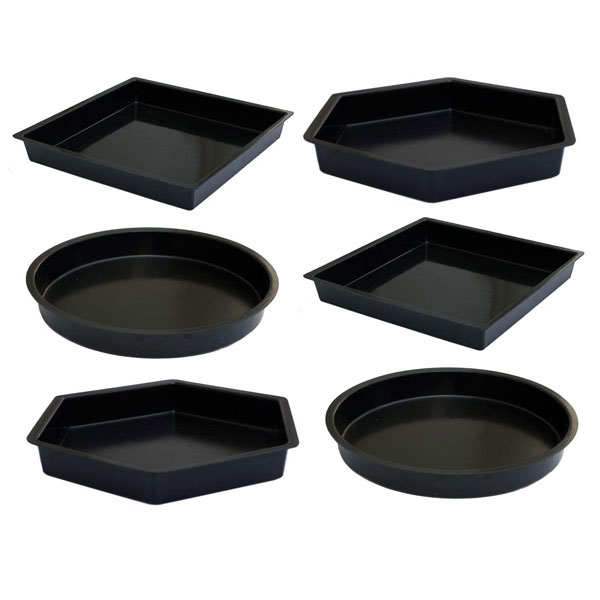Description
Mosaic Stepping Stone Mold is a durable ABS plastic form for making mosaics using wet concrete and glass mosaic tile. The mold comes with rounded corners and a slight taper to make it easier to remove the stepping stones after the concrete hardens. We use thinset mortar mixed with small pea gravel (2:1) for stepping stones, but many people use ordinary concrete. Both are available at the building material store. Stepping stones are perhaps the easiest mosaic project for children and beginners. You can use materials of different thickness because you are pressing the pieces into wet concrete instead of gluing to a rigid surface.
Mosaic Stepping Stone Mold
- ABS plastic for long life.
- Deep enough to produce stepping stones 1.5+ inches thick.
- Rounded corners and tapered edges for easy removal of hardened stones.
Compatibility
Tile of different thickness can be used in a stepping stone mold. You can also use a wide range of hard materials other than tile: found stones, glass figurines, toy glass marbles, glass gems, gemstones, quartz crystals, beach glass, etc.
Ceramic and Marble
Ceramic tile and unpolished marble can be used as well, but keep in mind that these materials are porous and susceptible to freeze damage. (Glass tile is nonporous and frost proof, so it is preferred for outdoors.)Souvenirs Yes. Plastic No.
Old souvenirs of glass and porcelain can give your stepping stone personality and charm, but avoid plastic because it is degraded by oxygen and the sun’s ultraviolet radiation.
Safety and Functionality First
No matter what materials you use, you should always take care not to create a slip hazard or leave sharp edges exposed. That includes not placing glass or ceramic objects in positions where they can be easily broken off. Never use large flat pieces of glass or fail to put a grout gap between smaller pieces of glass because that could result in a surface that is too slippery when wet.
Tip: If your mosaic stepping stone is ever damaged in such a way that a shard piece is sticking out, you can take a piece of rock and file the rough edge down by gently but firmly rubbing the rock on the rough edge (wear leather work gloves). A Marble File is also useful for this type of repair work.
Product Use
A thin coat of petroleum jelly (such as the Vaseline brand) or non-stick cooking spray should be used to lubricate the mold prior to each use. This ensures easy removal of the stepping stone once the concrete has hardened.
Most artists use the molds by pouring in wet concrete and then pressing tile in the surface of the concrete, but there is a second way the molds can be used: If you are wanting to make an elaborate design from ordinary flat tile, then you can stick a piece of contact paper in the bottom of the stepping stone mold with the sticky side up. Press your tile upside down onto the sticky contact paper. When all the tile is positioned, pour concrete on top of that and fill the mold to the top surface. Of course you should pour in a little concrete in at first and use your fingers in Grouting Gloves (gently) to make sure the concrete is making intimate contact with the tile and is in the gaps between the tile. Leave the stone in the mold for 24+ hours before removing to allow the concrete to harden.
How To Make Stepping Stones Last Longer
We seal finished mosaics with a grout sealer or concrete sealer for longer life, and you can also bring stepping stones indoors for the winter months to avoid harsh freezes.
How To Make Mosaic Art
For more advice on designing your mosaic project or mounting, cutting, and grouting tile, please see our page of Mosaic Frequently Asked Questions or our Mosaic Information Guide, which lists instructional pages described by topic. We also post new articles about making mosaics at our How to Mosaic Blog.
